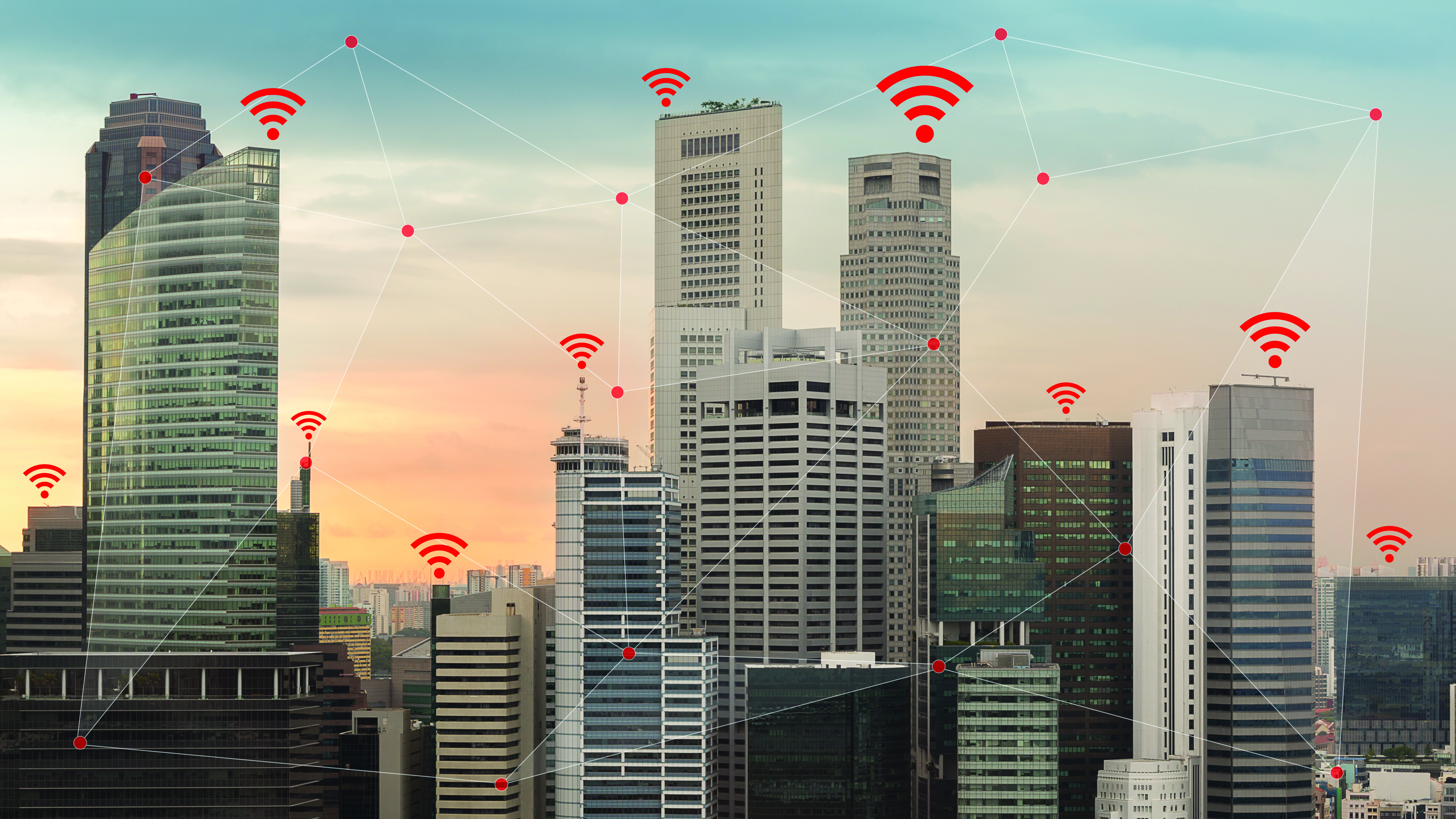The Internet of Things (IoT) promises us a more comfortable, convenient and safer life. A life with devices, appliances and even buildings that adapt to our needs. At the moment, IoT technology is mainly gaining ground in the consumer market – with people’s smartphones serving as user-friendly interfaces for services such as smart lighting, home monitoring, smart CO2/smoke detectors, smart heating and ventilation, voice command assistants, etc. But the IoT’s potential goes far beyond these clever home gadgets; as the technology matures, a myriad of new possibilities are opening up.
An important step – in addition to experimenting with consumer-focused IoT applications for smart homes – is creating smarter office buildings, i.e. buildings that do not only offer the highest level of comfort, but also the best energy-efficiency and safety.
Using IoT technology to track how a building is used, we can design offices tailored to our exact needs, without superfluous meeting rooms, or without air-conditioning that is on when no one is in the room. Equipped with the next generation of IoT sensors and radars, buildings will be able to tell how many people are in a room, where they are and what kind of (working) circumstances (temperature, illumination, etc.) they prefer. As buildings account for 40% of a city’s electricity consumption, installing IoT capabilities will significantly contribute to achieving the global electricity reduction goals.
A strong match: pairing up hard- and software
Today, affordable technology exists to detect people’s presence in a room, but not their exact number, their activity, or their exact location. In 2017, our teams demonstrated radar-based classification of various human movements, as well as remote respiration and heart beat detection. Today, these measurements still require body-worn devices, but our radar-based technology can now be integrated in the environment and perform these measurements at multiple meters of distance. That has never been shown before and holds big promises. This technology enables accurate analysis of presence, movement and life signs, while – unlike current camera-based solutions – preserving privacy.
Yet, to enable smart buildings, you do not only need the best hardware to gather accurate data; you also need the right algorithms to turn that data into knowledge.
At imec we have the in-house expertise to do both. We can support the whole solution process: from creating the best sensor and radar designs to developing the best algorithms. We can also prove the device capabilities in a real application, with real-life artifacts. Our solution approach, where we combine hardware and software capabilities, and test in real-life environments like at imec’s HomeLab and OfficeLab is key for imec to succeed in the IoT landscape.
Fine-tuning the IoT’s building blocks
Much of the technology that we need to realize tomorrow’s smart buildings is also useful in other areas. At imec, we take a broad approach to the IoT: we’re working on different technologies with the potential to support IoT innovation in multiple areas. For instance, we’ve developed some essential building blocks for 5G communication, including record-breaking analog-to-digital convertors (ADCs), reconfigurable low-noise frequency synthesizers, millimeter wave phased array transceivers, antenna modules and more. In addition, we develop radars for autonomous cars operating at 79GHz – e.g. for people and collision detection. Typically, our radars offer a 10x higher angular resolution, while consuming half the power at lower cost in high volumes. In 2017, we’ve also developed intellectual property for new IoT communication standards like NB-IOT and Cat-M1, supporting long-range Cellular IoT. For short-range IoT solutions, where many radio ICs are widely available, we further reduced the area (and thus cost) of a Bluetooth IC by a factor of 3, while operating from the smallest and lowest-cost batteries around.
What sets this field apart from other imec research is that our IoT projects have exceptionally high technical readiness levels (TRL). For instance, our liquid ion sensor is currently sampled as a development kit to lead customers, while transferring manufacturing knowledge to industrial partners. This liquid ion sensor is particularly interesting because it offers so many different possibilities. It allows for simultaneous detection of multiple ions in a liquid, with a longevity of over 6 months. The sensor can be used in many different fields, from monitoring water quality to the fine-tuning of the fermentation process of beer. This kind of application-driven innovation takes up a central position in our IoT roadmap.
The IoT’s Achilles heel: security
Although the Internet of Things promises to bring enormous benefits, we cannot ignore the risks associated with it. Many current IoT devices have relatively weak security capabilities and are easy entry points for hackers. Imagine hackers reading your home’s thermostat settings, allowing them to know exactly when no one is home. Or worse: a hacker messing with the braking system of your (self-driving) car.
The reason for this exacerbated cybersecurity risk is two-fold. First of all, there is no real form of standardization yet. Each device still speaks its own ‘language’, making it very hard for the network to know which devices to really trust. Secondly, there is the commercial aspect: the cost of building extra security into these basic devices is often too high for commercial purposes. Therefore, reducing the cost of lightweight hardware-entangled security solutions is a priority research objective for imec.
In 2017, we demonstrated the first results of our Secure Proximity technology, which can be used to enhance the security of Bluetooth-enabled smart locks. These smart locks are very convenient, because they enable access control from your phone and can stimulate new services, like sharing cars, apartments or lockers, in the sharing economy. But this first generation of smart locks is very vulnerable to hacking. Examples of smart lock hacks hit the news on a monthly basis. That is why we are working on a next-generation smart lock with better accuracy and stronger security. For smart locks to be reliable, first, an accurate distance estimate is needed between the authorized phone and the lock. In addition, the distance estimate needs to be implemented in such a way that it is hard to falsify. In 2017, we have achieved a 5-fold improvement on the accuracy of the distance estimate (i.e. errors below 30cm) as compared to the state-of-the-art. The measurement is protected via an authentication protocol, that has been co-designed with the distance estimation. This imec technology represents a major breakthrough towards secure and reliable smart locks.
Looking ahead: 2030 and beyond
IoT technology holds great promise. Research in this field is moving at an incredibly fast pace and is almost catching up with our visionary dream of an interconnected world. By 2030, the cost of smart IoT nodes will presumably have dropped below 0.5$. New sensors will have flooded the market and will monitor every aspect of our lives, giving rise to a wealth of new applications and services. Buildings will generate useful data on various parameters, creating highly customized spaces that meet our every need. I can’t predict which field will be transformed most by the IoT revolution, but it’s hard to imagine any field that will not be affected. At imec we will be at the forefront of that innovation with an initial focus on expanding our IoT strategy for smarter buildings with relevant and leading innovations.


John Baekelmans, vice-president
of imec’s IoT and Connected
Health Solutions Group &
managing director, imec
Biography John Baekelmans
John Baekelmans is vice-president of imec’s IoT and Connected Health Solutions Group & managing director at imec the Netherlands. Imec in the Netherlands develops technologies for wireless autonomous sensing solutions, innovative connected health solutions and flexible electronics in an open innovation setting and in dedicated research trajectories.
John obtained a Master’s degree in Computer Science from the University of Antwerp, Belgium and is a former Cisco Certified Internetwork Expert (CCIE). Before imec, John spent 21 years at Cisco where he held various global leadership positions within Engineering, Services and the M&A departments and has authored numerous US and European patents. John was also the co-founder of a Belgian residential solutions startup called Fifthplay. Before Cisco, John designed, implemented and operated large PBX-networks at Siemens.







